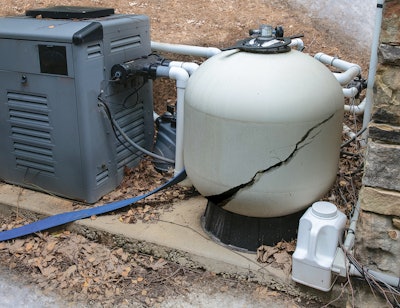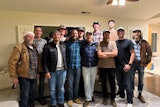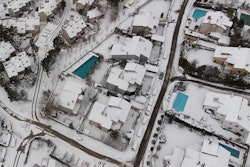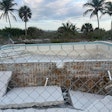
You can't really call it a mistake because it was intentional.
Pools in Texas have been intentionally designed, built and maintained to pass the off-season without the winterizing procedures much of the North employs each year. They don't blow out the lines and equipment and lower the water level. They don't worry about freeze damage.
That always seemed like a waste of time and money because if, God forbid, the temperature ever dropped far enough below freezing to endanger equipment, they could just circulate water until the weather moderated — a day or two at most.
But this year on Valentine's Day, something nobody ever thought could happen, happened. A winter storm hit and drove temperatures to shocking overnight lows, which wasn't inconceivable by itself, but that same storm knocked out the power supply. That second bit was the part nobody had seriously thought about.
"People went to sleep Sunday evening, and the temperature dropped and the power cut off in the middle of the night. When they woke up the next morning, they'd been five or six hours without power, and everything was already frozen," says Nick Day, service manager for Gohlke Pools in Denton, Texas.
RELATED: Texas Rebuilds
"The situation was made worse because as the temperature dropped, it activated the freeze guard on the pumps, so those pumps were running right up until the instant the power cut off. So at that point, the filter's full of water, everything's pressurized, and then suddenly, it all just goes silent and starts freezing. So by the time you woke up in the morning, five hours later, the filter's cracked, the pump housing's cracked, the valves were cracked, everything. It was just a catastrophe."
The extent of the damage depended largely on how your local utility handled the crisis. In Denton, north of Dallas, the local power company was able to use rolling blackouts to avoid extended power shutdowns. Power was cut for an hour, and then restored for an hour throughout the district, which allowed most customers to limp through the worst of the freeze with limited damage.
"We still had some customers who lost power and equipment, but it wasn't as bad as some of the bigger pockets around Dallas, Austin and Houston that lost power for days — maybe three or four or five days. In those areas, of course, everything just froze.
"But even here in Denton, which wasn't as hard hit as some places, we had to replace a lot of equipment. And it was just a scramble. That night, I didn't sleep at all. I just took phone calls all night for people. And by morning, we were already seeing pictures of the damage coming in.
"We immediately knew what we were facing, so right then we just started ordering everything we could. I probably bought a million dollars worth of equipment in that first week. And we were kind of wondering like, 'Oh God, are we betting too big on this?'... But of course it wasn't nearly enough. Soon we were wishing we had more."
THE LONG ROAD BACK
And so began the herculean job of rebuilding the Texas pool and spa industry. At first, facing at least 100,000 downed pools, the industry responded with an adrenaline rush and frantic activity, as out-of-state professionals arrived on the scene and local companies ramped up for a furious effort. But soon it became obvious that this would be a marathon, not a sprint.
RELATED: A Texas-Sized Pool Equipment Disaster
"For a week or two, our technicians were working seven days a week," says Day. "But they just couldn't keep up with it. And so we dropped to six days a week, and then dropped to five days a week. We were just trying to get it running, keep it brushed, keep it moving around until we can get everything fixed."
Like any pool business, Gohlke Pools worried about losing customers due to delays in restoring their pools, but soon realized everyone was pretty much in the same boat. "Customers couldn't call anybody else. I mean, nobody else had any equipment, either."
In fact, during that period, companies that were able to secure replacement equipment got a boost. "We didn't advertise that we had pool equipment or anything like that, but inevitably, some people got tired of waiting on their current pool repair provider and called us, and we responded. So in the end, we picked up a lot of new business.
"I still get an occasional call now, like 'I'm tired of waiting on my pool company to fix this.' Or maybe the system's up and running, but they haven't been able to fix the heater. And we have heaters, so we get them fixed up."
A THOUSAND TO ONE SHOT
One way of thinking about this historic equipment disaster is to say: "We need to fix this right away so it never happens again." Another way is to say: "This combination of events was a thousand-to-one shot. It's not going to happen again."
RELATED: Dispatch From the Front: Rebuilding Texas
Which way does Gohlke Pools see it?
"A little bit of both," says Day. "I mean, we actually talked about it this morning. We will put together a game plan for all of our regular service customers. We know we need to be ready for a lot of questions this fall and winter. But I think, in reality, the chances of us having that happen again is... well, I don't think it will. It was a once- in-a-hundred-year event.
"And so when new pools are being built right now, they're not really considering that. They aren't being designed to be winterized for that kind of temperature. We're not equipped to do things like you do in the North where you blow out skimmer lines and all that kind of stuff.
The Equipment Recovery
Not only was the St. Valentine's Day pool equipment massacre an incredible confluence of events — a "perfect storm," if you will — the staggering loss of equipment it caused could not have been timed any worse for the wider industry, which is in the midst of a historic shortage of its own: Manufacturers that were already losing ground were suddenly presented with a six-figure order from the state of Texas.
"It's going to take a long time to catch up," Day says. "The problem is there's nothing on the shelves. At the distribution level, there's just nothing in stock. I'm sure they're trying to take care of the builders first, and obviously that's a high demand, so that's taking a lot of product.
"But for single-person pool companies? I don't know how they're getting stuff. And there are still some areas out there that haven't got everything replaced yet because it's just not available.
"I think it will be 2024 before you can buy off the shelf at your distributor. We're ordering well into 2022 right now, and it's still a six to eight month lead time on a lot of things."
As everyone in the industry is aware, shipping was backed up before the storm, as manufacturers have been struggling to untangle their own complex supply lines.
"They're certainly making the stuff as fast as they can. They've done a really good job with communicating lead times and keeping everybody abreast of the problem.
"I just know a little bit about Pentair just because we're a Pentair dealer, but I know they're adding manufacturing capacity, adding new production lines. I mean it's hard to go out there and just build a million square foot manufacturing facility, but you know, they're probably moving office people out and letting them work remotely, so they can fill the space with new heater lines. (Laughs)"
This article first appeared in the October 2021 issue of AQUA Magazine — the top resource for retailers, builders and service pros in the pool and spa industry. Subscriptions to the print magazine are free to all industry professionals. Click here to subscribe.












































